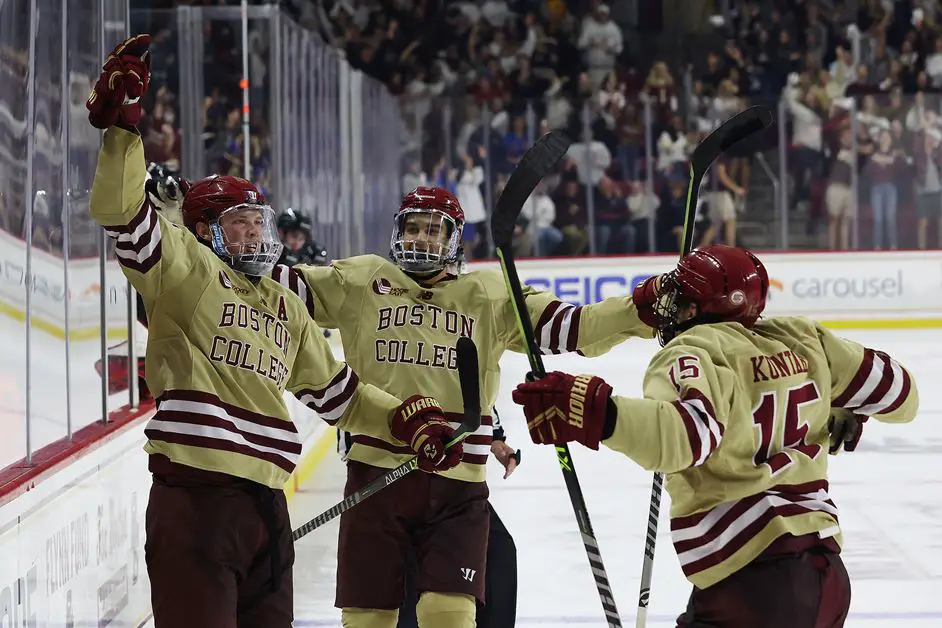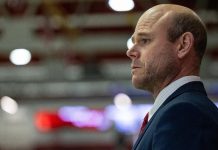
Each week during the season, we look at the big events and big games around Division I men’s college hockey in Tuesday Morning Quarterback.
Dan: Alright, here we go with another week of TMQ.
It feels great to be back in full swing with college hockey season – although not full FULL swing because we haven’t picked up the Ivies yet – but for me, it’s been one heck of a start of the year. Also very excited to be part of our national coverage and already pretty proud of what we’re going to accomplish with this endeavor.
Jimmy, you and I had an interesting weekend up here in the Northeast, but this felt like one of those weekends where some teams really asserted themselves.
For me, the game of the weekend was Bentley’s win over Boston College, largely because it was a seismic win for the Falcons, who have a history of knocking those teams off, but I know you were at Conte Forum the night before watching the Eagles take on Northeastern. That game already feels like a frontrunner for game of the year, but take me back to Friday night. You don’t know that BC is going to lose on Saturday night, what are your observations walking out of that building?
Jim: The atmosphere was excellent at Boston College – as it has been at a number of buildings thus far this season – on Friday night. For me, that was my first return to a packed arena and some sense of a return to normalcy, so that stood out in my head.
The game itself, as you said, was incredible. Northeastern used a strong second period to seemingly take control of the game. But BC scored a late goal in the middle stanza and then two in short order midway through the third to take the lead it wouldn’t relinquish.
I felt coming out of that game that BC deserved mention as one of the nation’s best teams.
And then Saturday happened.
I’m not taking an ounce away from Bentley, but BC had a letdown between Friday and Saturday and the Falcons pounced. You were in the building, but five goals in the third period tells me one thing — BC got run over by momentum.
And while those two games standout to us, it’s likely the biggest game of the weekend might have been played in front of almost no one as Michigan beat Minnesota State, 3-2, behind two third period goals. That gave the Wolverines the IceBreaker (the western version) title and helped them ascend to No. 1 in the USCHO poll.
Michigan is now 4-0-0 and boasts the best roster of talent in college hockey. My question to you is how high should be set the bar for Michigan?
Dan: I agree with you wholeheartedly about momentum. The crowd was a big part of Saturday night’s upset, especially in the third period, and while that building at Bentley is certainly smaller than Conte Forum, the 2,100-plus people in the arena returned the life to college hockey that we all missed.
So, welcome back everybody. It felt, if you’ll indulge me up here in Boston, so good, so good, so good (despite the fact that I notably loathe the eighth inning singing at Fenway Park).
I’m subject to hyperbole, but I believe Michigan is the best team in college hockey.
That was the hyped billing entering the season, and this weekend proved it with the way that team won the IceBreaker. Beating Minnesota Duluth decisively is one thing, but I thought Minnesota State outplayed the Wolverines for a long swath of that game and still lost. Dryden McKay, a goalie who recorded a shutout as I was typing this up, made less than 20 saves and lost. That’s one statistical sign, to me, how efficient Michigan was in their moments, but the Mavs were also much better in the faceoff circle.
We all know how staggering the talent levels are at Michigan, but it’s not easy to navigate those players into a single, cohesive unit. There’s a lot riding on each of those individuals when seven were first round draft picks and 13 of the 28 players on the roster are, in some capacity, selections by NHL franchises.
Four of the first five picks all play for Michigan, and a fifth player – Mackie Samoskevich – was the 24th overall pick. Brendan Brisson scored two goals on the weekend and was the only player to strike in both games, and he was on the U.S. World Junior team last year with Matty Beniers.
That pressure is compounded by the weight of expectations that we’re all placing on this team. When you have that talent, there’s an expectation to go out and beat every opponent, but Mel Pearson has clear buy-in to blend that talent beyond playing as an al-star team. They skated with flow and creativity. Michigan faced adversity against Minnesota State but overcame it after a huge win over Duluth.
At some point, a loss will be a teaching moment and another opportunity for us to see how the players’ elevate their game in response. One look at that team, though, and yes, this is the best team in college hockey right now, and if they stay on this trajectory, we’re all just living in Michigan’s world for the foreseeable future.
I want to switch gears altogether to something Ed Trefzger pointed out in his Monday 10 recap this week. During an interview with RIT this weekend, athletic director Jackie Nicholson remarked about RIT’s partnership with Union to apply for a full complement of scholarships for men’s and women’s hockey. Each of the six conferences are supporting those programs, and the vote is scheduled for the end of January.
That caught me by surprise, but it was, to me, a clear indicator of how college hockey continues to shift under the surface. How much of a game changer would this be in those leagues considering the track records of both Rick Bennett and Wayne Wilson in building their brands of success those two programs?
Jim: I realize that scholarships are a game-changer for any program, but my understanding is that schools that don’t offer scholarships can often gain an advantage.
Years ago, I was told by a coach at a non-scholarship school that there is ability to give what schools call “grant-in-aid,” in other words if a player can qualify for aid, there are ways to give that player a grant. Said grant wouldn’t count against an 18-scholarship limit that every school currently faces. So if you can find a large number of student athletes that qualify for some sort of grant-in-aid, there is the potential to have almost equal or more scholarship power.
Now this was in the days when Atlantic Hockey teams were limited to significantly less than 18 scholarships, so I understand that schools like RIT and Union would feel like they could get on equal footing to their opponents if they were allowed the full complement of 18.
Let’s be real. It’s not like RIT and Union were never successful without scholarships. RIT reached a Frozen Four and Union won a national title. There had to be creative ways for each school and many others – the Ivies come to mind – to entice students to enroll that made those programs successful. Would adding scholarships make the whole accounting a lot easier? Yes. And I think most coaches in the nation would prefer that approach.
Dan: I guess that’s my whole thing.
Programs without scholarships have a path towards success if they develop creative ways. That doesn’t mean we’re implying nefarious methods or anything like that, but the fact remains that those teams had to develop systems and workarounds to build winners. In Union’s case, it took over a decade since it wasn’t like the reclassified program enjoyed these massive layers of success. I remember when the Dutchmen routinely struggled to consistently break into the ECAC elite class, and none of those first coaches – Bruce Delventhal, Stan Moore and even Kevin Sneddon – were able to build consistent winners.
It wasn’t until Nate Leaman was able to sustain the build that Union earned a first round bye and then won a league regular season championship, and Rick Bennett took it to the next level with two Frozen Four appearances and the national championship.
RIT is more mercurial to me because the jump to Atlantic Hockey came against a conference that had three or four programs struggling to even stay afloat at the time. That team made the jump and immediately won the league regular season championship despite being ineligible for the postseason, and within four years, it won a league championship and advanced to the league’s only Frozen Four appearance.
As the years have marched on, RIT was able to rediscover its sustained success after it opened the Gene Polisseni Center. The rest of Atlantic Hockey hadn’t invested as firmly in facilities or advancements at that point, and in the five years since, RIT’s been a factor but not the same dominant team within the league. Granted there are other factors, but the elevation of scholarships in 2016 clearly had a dramatic effect on other teams that concurrently moved into new facilities.
I reiterate that there are other factors, but I do agree with one major, overlay here. A team without scholarships still has to get creative, and it requires a much different buy-in at the university level. We don’t know the intricacies or inner workings of those institutions, but we all have to think that the scholarships would make a much bigger deal and simplify a process that is often mysterious and misunderstood, especially, probably, by me.
As we look ahead for this week, I know it’s way too early to talk about the national tournament, but every coach tells us how league points are always important but you want to play your best hockey at the end of the season. Is the truth more in the middle?
Jim: I feel like my most dramatic cliché surrounding college hockey is that games in October matter just as much as games in March. It’s difficult, sometime, to become motivated for the early-season games, but I feel like this year is a bit different.
After last year’s disaster and the multiple cancelations due to COVID, it seems like upper-class players understand that each game is a moment that was and is never guaranteed. I have only been in attendance for five games thus far, but every time a team takes the ice, there feels like there is significantly more energy. Is that because so much hockey was lost to COVID? Maybe.
But I know as an observer, I enjoy it. I want to see teams play in October with the energy they would later in the season. Sure, the play can be sloppy, but you want to see desire and right now my experience says teams are playing with plenty of desire.


